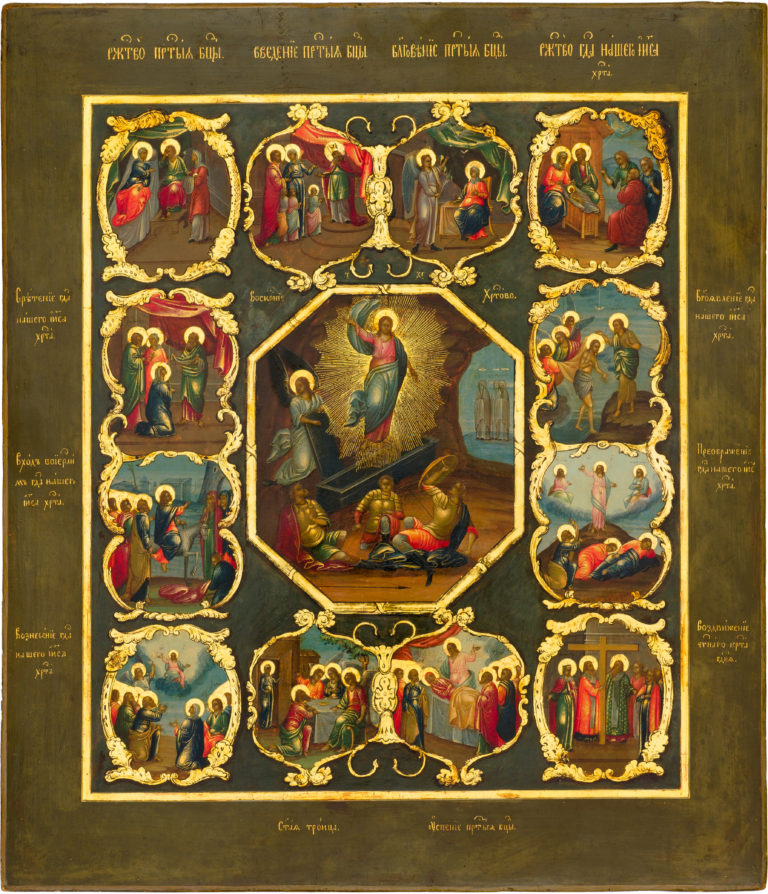The Resurrection, with Church Feasts in 12 Border Scenes
Antique Russian icon. Second quarter of the 19th century. St. Petersburg or Moscow.
Size: 36 х 30.5 х 2.5 cm
Wood (three panels), two incut profiled support boards, absence of an incut centerpiece, underlying layer of gesso not visible, gesso, tempera, gold.
The author’s paintwork is in very good state, with only several places with small fallouts of the paint.
Contact us

The Resurrection, with Church Feasts in 12 Border Scenes
Diagram of the border scenes:
- The Nativity of the Mother of God;
- The Entrance of the Mother of God into the Temple;
- The Annunciation;
- The Nativity of Christ;
- Candlemas (The Meeting of Christ in the Temple);
- The Theophany (The Baptism of Christ);
- The Entrance intro Jerusalem;
- The Transfiguration;
- The Ascension;
- The Old Testament Trinity;
- The Dormition of the Mother of God;
- The Elevation of the Holy Cross.
The Resurrection of Christ is among the most popular themes in Russian religious icon art. Hand-painted icons of the Resurrection were often commissioned for churches, with small-sized images being placed on the analoion for veneration by the faithful during Sunday services. However, such Orthodox Christian icons were also used for home worship. The popularity of these images – arrayed with border scenes of Feasts – is obvious: the composition encompassed the main events of the liturgical year, with its main Feast – Pascha (the Resurrection of Christ) in the religious icon centerpiece.
Despite the fact that all Gospels tell of the Resurrection of Christ (Matthew. 28:1–20; Mark. 16:1–18; Luke. 24:1–49; John. 20:1–29), neither actually describes the event itself; it remains shrouded in mystery. Nevertheless, already in the Middle Ages, Russian icon painters embraced the ‘Rising from the Tomb’ scene that was taken from Western European etchings. It depicts Christ – Risen from the Dead and Rising over a tomb, the lid of which is held by an Angel, while the frightened Roman warriors, blinded by the radiant light, try to cover themselves with their shields. This version of the Resurrection won its greatest popularity in the Imperial period, with various Western European etchings serving as samples, namely – the Piscator Bible published by a Dutch engraver in the late 17th century, which was widely used as the main sample by Russian icon painters in the following century.
In the centerpiece of the given hand-painted icon, the Savior is depicted frontally with His arm raised, wearing a tunic and a broad himation, which makes this antique Russian icon differ from the majority of “The Rising” scenes, where Christ is usually half naked. The triumphant character of this scene echoes the spirit of the Imperial period when the “Rising from the Tomb” actually displaces the traditional “Harrowing of Hades” depictions. The events take place in the dark cave, at the entrance of which we see three Myrrh-bearing women, the closest disciples of Jesus who, according to the Judaic tradition, came to wash the body of Christ with precious oils. The Eastern Orthodox iconography of the border scenes also shows Western orientation reworked in a traditionalist manner. In the Annunciation scene, the Archangel Gabriel stands with lilies in his hand before the Mother of God, who is shown seated at a table; in the Nativity of Christ, we clearly see the Adoration of the Magi; in the Candlemas scene, the Prophetess Anna is unusually shown falling to the feet of Simeon. The interior scenes of the given antique icon clearly reveal the artist’s acquaintance with linear perspective. The compositions are framed by vivid cartouches – gold with black graphics – that imitate gilt baroque woodcarving. The precision and beauty of the ‘miniature’ painting style enforce the overall triumphal, festive character of this beautiful Eastern Orthodox icon.
The artistic traits of the piece, namely its desire to follow Baroque forms, the intense and seemingly condensed color scheme, the execution of the vestments, the energetic and diverse poses of the characters along with the draft-like painting style, the symmetry of the cartouches, and the highly-ordered ornamentation – all reflect the “Second Baroque” style, a retrospective movement popular in the second quarter of the 19th century. The overall mastery of this antique Russian icon indicates that it was painted in either Moscow or St. Petersburg.